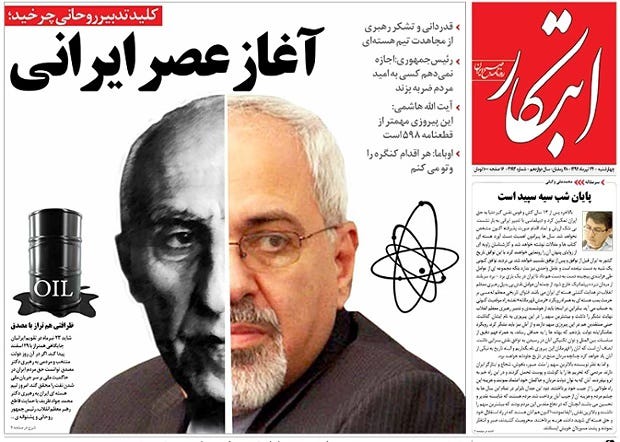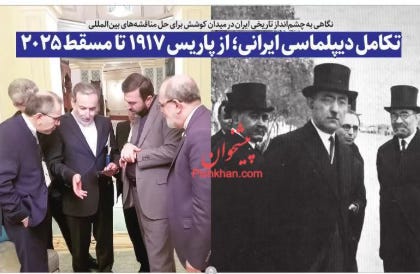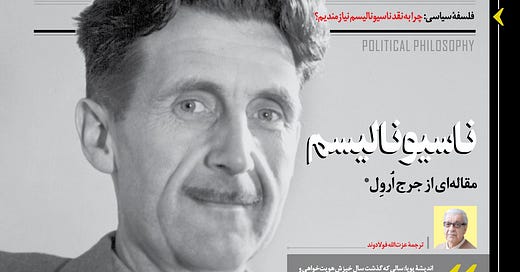The current catastrophe unfolding in Iran has its roots in revolutionary ideology and the cultivation of an obsession, a prestige project that remains stubbornly indifferent to reality. This is nationalism, as Orwell would define it, at its worst, the politics of ‘principle’ that seeks to enhance the power of the ‘nation’ at the cost of the Iranians themselves. A contextual piece prepared before the Israeli attack on the 13th June it is intended to complement the piece I wrote on the history of Iran’s nuclear programme written for Engelsberg Ideas.
Back in 2017, the literary and philosophical journal Andisheye Pouya published a translation of Orwell’s ‘Notes on Nationalism’. Orwell’s piece sat alongside translations from other more contemporary writers and political thinkers including Francis Fukuyama, Margaret Macmillan, and interestingly a piece by Tony Blair that had been lifted from the New York Times. Iran, not being a signatory to the Berne Convention on copyright has little problem using such pieces and setting such legal niceties aside, there is merit in seeing them disseminated in Iran.
This was the time of the first Trump Presidency, so running articles on populism and authoritarianism seemed apposite and the translator pointedly drew attention to the relevance of this piece to developments in Europe and America. It would nevertheless, not take enormous self awareness for an Iranian reader to see the relevance of Orwell’s critique to developments closer to home. Orwell, acutely aware of the contentious nature of the discussion sought to distinguish ‘defensive’ patriotism1, from the ideological and aggressive nationalism whose:
abiding purpose…is to secure more power and more prestige, not for himself but for the nation or other unit in which he has chosen to sink his own individuality.
The early ideologues of Iranian national identity sought to foster patriotism but ended up - to the vocal regret of some - in unleashing its less savoury brother - nationalism -and the ideology has been a staple of Iranian states since the early 20th Century. The leaders of Islamic Republic have never been shy in deploying it, often more instrumentally and cynically than their predecessors.
Iran’s nuclear programme offers an excellent example of Orwell’s critique in practice. This is at heart a prestige project intended to secure power for the ‘nation’, pursued with an obsessive determination that brooks no deviation, and increasingly indifferent to reality. In many ways Iran’s nuclear programme serves, and has become prisoner to, the ideology. ‘Nationalism’ is enthusiastically cultivated to provide refuge for a regime that has exhausted its other options as far as the wider Iranian population, disillusioned by revolutionary ideology, is concerned. In times of heightened tension, as we have today, the recourse to nationalism increases exponentially but the nuclear program has long served as a means of cultivating nationalist legitimacy, and the current regime’s role as the heir and carrier of the national flame
On several occasions Iranian ministers have stressed the similarity between the last Shah’s policies and their own, expressing bewilderment that ‘for some reason’ the United States after 1979, took against Iran. This extraordinary exercise in whitewashing the impact of the Islamic Revolution is all the more remarkable because much of regime ideology stressed the emphatic break that 1979 represented, not least for foreign policy, and for good measure the inherent wickedness of the Shah. Indeed, in 1979 the revolutionaries shut down the nuclear programme as a Western inspired waste of money, and imprisoned the scientists involved.
One must never let the facts get in the way of a good ideology. Showing a bold indifference to historical realities, the Islamic Republic argues that it is simply continuing a project launched by the Shah, which it adds was fully supported by the United States. This position is however undermined by the fact that the United States was never in favour of Iranian enrichment - much it must be said to the Shah’s frustration - but this has simply resulted in a rhetorical pivot to argue instead that since the Shah also favoured enrichment, this reinforces its national legitimacy2.
But deeper continuities have also been alluded to in order to provide a sense of nationalist purpose, not least an identification with the prime minister who sought to nationalise the oil industry in Iran in 1951, Dr Mohammad Mosaddeq, overthrown in an Anglo-American inspired coup in 1953. By drawing a genealogy back to Mosaddeq the regime is seeking to inherit the mantle of national champion from the icon of Iranian nationalism. More than this, the regime is suggesting that the Islamic Republic is succeeding in its own fight where Mosaddeq failed.

This narrative has appeal, certainly to those secular nationalists who have no truck with the Islamic Republic, including many in the diaspora. It offers a means to reconnect for those disaffected with the Revolution, and effectively taps into a collective emotional bond, that many, not least those far from home, yearn for. The ideological veneer, is however just that, since Mosaddeq’s nationalism (more akin to Orwell’s patriotism) is a world away from anything practised in the Islamic Republic, and the leadership of the Islamic Republic has regularly expressed its disdain for what it regards as Mosaddeq’s pro-American sentiment.
But the latest historical revisionism has suggested that there is a link between Foreign Minister Araghchi’s negotiating team and that which fought Iran’s corner at the Paris Peace conference in 1919. The absurdity of this claim is reflected in the fact that most of the individuals pictured with their top hats in Paris are regularly denigrated if not altogether loathed within regime ideology.

The purpose of all this is clear: to provide legitimacy through continuity and to reinforce the view that what is being pursued here is a ‘national right’ which transcends the particular political system in power. In this respect perhaps the allusion to 1919 is not inappropriate after all, since it was in this period that the principle of ‘national self determination’ entered the political lexicon with the suggestion that ‘nations’ enjoyed ‘natural’ rights. This contribution of Woodrow Wilson to international relations has remained controversial but it has successfully embedded itself within political discourse and is deployed to great effect when weaker powers seek to establish themselves in the face of stronger powers.
Its deployment however has been selective, and the Islamic Republic is no exception. National rights and self determination can’t apply to everyone who appeals to it - that would be a recipe for disaster - but they are also increasingly the purview of States, rather than ‘nations’ (the rights of individuals seem secondary). Iranian statesmen have proved remarkably adept at defending Iran’s territorial integrity and sovereign rights at various legal tribunals throughout the 20th Century. Applying it to the ‘right to enrich uranium’ brings up some strange incongruities, not least because of the Islamic Republic’s wilful disregard for other more fundamental rights but also because it has drawn its plans from a different era.
In the 1970s the next great industrial leap forward was felt by many to be represented by nuclear technology, and the Shah was determined that Iran should be leading it. This was economic nationalism at its most ambitious but it was coherent and it had a plan. Iran had the money and the friends, the international environment was sympathetic if not always supportive and the Shah’s plans for a twenty nuclear reactors (originally to be built by Britain3), was part of a wider plan for energy diversification - including solar power.
Having initially dismissed the Shah’s nuclear programme as a western conspiracy to siphon off money (Ayatollah Khomeini also notoriously lampooned the Shah’s ambitions ‘to harness energy from the sun’ as fantasy), the programme was resurrected in 1984 as the revolutionary government became aware of Iraq’s nuclear programme. The impetus for the Islamic Republic, then grinding out a protracted war with Iraq, was clearly different.
But it effectively appropriated the Shah’s plans - and his economic justification - divested of its wider context and its broader energy strategy. More obviously the vagaries of revolutionary Islam ensure that there was little if any prospect of twenty reactors being built. Indeed so far Iran has a single reactor - completed by the Russians in 2011 who supply the enriched uranium required. In the midst of power shortages Iranians rightly question why so much investment has yielded so little. There is nothing else in the pipeline.
Such realities were irrelevant to the growing demands of nationalist ideology which naturally solidified as Western concerns grew in the 1990s. There is nothing that nationalism loves so much as a grievance, and nothing so empowering as Western opposition to feed it. (I once remarked to an Iranian official that the West had hit on the best idea to bankrupt Iran. By simply saying ‘No’ to enrichment they ensured that the Islamic Republic would instinctively throw money at it. There was pregnant pause until I reassured him that I was joking). A revolution nurtured on grievance against the West discovered the ideal fuel, and so Iran’s nuclear programme transcended the needs of economic nationalism and became a principle.
This was about the West preventing Iran’s modernisation and the grievance mattered more than the substance. It became an obsession that was indifferent to the realities that Iran’s Revolution had done so much to change. And if the Shah found it difficult to persuade the West of Iran’s right to enrich, how much more difficult would it be for a disruptive revolutionary republic who talked transparency and practised obfuscation.
Like all Treaties the Nuclear Non Proliferation Treaty (NPT) requires interpretation, and all interpretation takes place in context. There is no explicit reference to enrichment in Article IV and access to technology is dependent to adherence to Article II. Both are disputed and would certainly benefit from clarification. But it has concentrated the mind and focused the grievance. As an ostensibly legal dispute that drew attention to Western ‘double standards’, it enjoyed an emotive force. It was just what the revolution needed to bind a recalcitrant and rebellious people to itself. Indeed, it has arguably resonated most forcefully with a diaspora that pays no costs for this nuclear nationalism.
The person most responsible for turning this nonsense into a performance art was President Ahmadinejad (2005-13), complete with dance troupes and Iran’s mythical heroes, championing the ‘right to enrich’, (while, lest we forget, denying the Holocaust and Israel’s right to exist), with diplomats eagerly handing out ‘centrifuge’ keychains to their foreign counterparts.4 The performance was devoid of all practical relevance other than establishing a ‘right’ and many Iranians joined in the nationalist pantomime blithely juxtaposing their own lack of civil and human rights with the State’s ‘inalienable’ right to enrich uranium.
As perverse as this is, it has been a highly effective campaign, not least because designating something a ‘national right’ has shut down opposition and prevented any serious questions. People who suggested that the money would be better spent on schools and hospitals were regarded at best as simpletons and at worst, traitors. The truth is there was a rationale to Iran’s nuclear programme in the 1970s, but this has long dissipated.
Iranian officials brag about their ambitions for ‘industrial’ scale enrichment, and the scale so far achieved exceeds anything that could be required for civilian or medical use. It cannot come as any surprise that it raises suspicions. But it has to be pursued whatever the costs to wider society because it is a matter of principle that brings power and prestige to the nation. It is not without reason that Einstein called nationalism, ‘an infantile disease…the measles of mankind’.
The truth is Iran’s nuclear programme is not founded on legal principle. It is a nationalist project - not without merit - but its ‘principles’ are founded on an ideological construct. Such legal points cannot be interpreted outside the political context (as any Shia cleric would understand). The ‘rights’ it champions are invented, and some way down the scale of priorities. The Islamic Republic would have a more persuasive case if it respected those fundamental human and civil rights for which it has shown consistent disdain, and discontinued its ideological opposition to the existence of the State of Israel.
In 1919, Iran’s statesmen championed Iran’s sovereignty and territorial integrity. They sought to build a state in which national rights complemented individual rights. On the latter point they were far from successful but their aspirations were sound. Their’s was a patriotism that was cosmopolitan and internationalist. Their putative heirs squandered that legacy on an obsession which has done little to enhance Iran’s political and economic security and much to harm it.
The translator uses mihan-parast (worshipper of country) for patriotism. A more appropriate term would be mihan-doost (lover of country).
Appealing to the late Shah’s musings on politic and power have increased in recent years.
For details see my ‘The Curious Case of the Nuclear Company of Britain and Iran’, IRAN, 55:1, (2017) 73-86, http://dx.doi.org/10.1080/05786967.2016.1277098
I had acquired one of these and very much regret giving it away.





Fascinating to see the strands of Iranian history and the points at which they become tangled and unintelligible. Any régime knows the unifying and nourishing power of an external enemy and the Great Satan has sometimes provided this too effectively. It would be interesting to know where committed but realistic members of the Iranian leadership see the Islamic Republic in, say, 2045 or 2050.